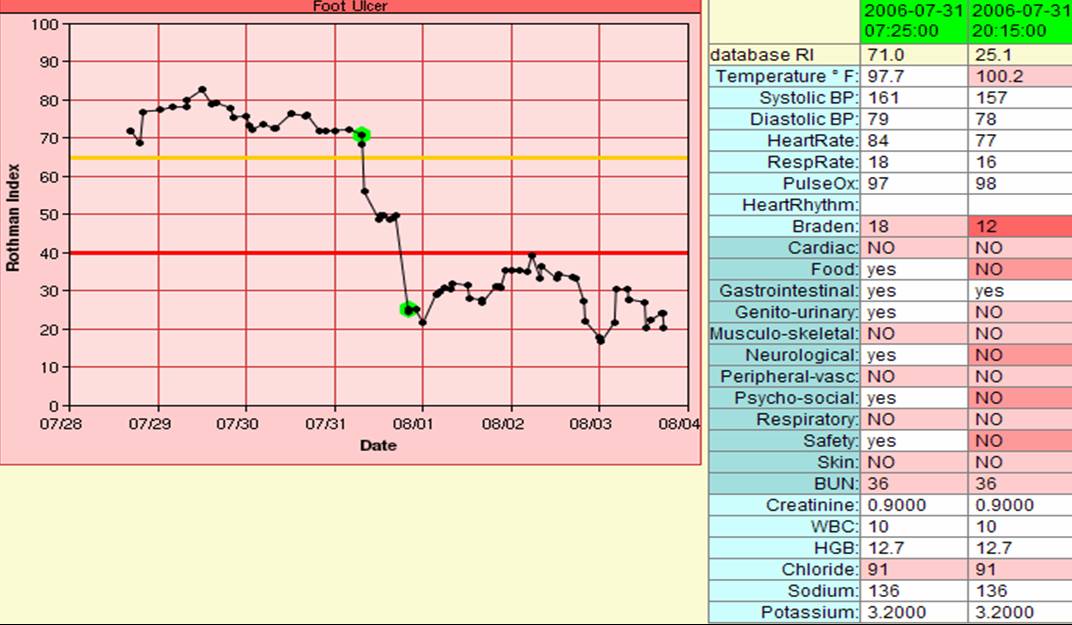|
Stories
From Life
|
Florence Rothman's Story
It wasn't surprising that an 87-year old woman wasn't feeling great after heart surgery. But what couldn't be seen by the different members of the team caring for her was that, instead of slowly improving as she was supposed to, she was instead slowly but steadily declining day by day. No one-day decline was enough to cause alarm. She was, after all, 87 years old. Until it was too late. After she died, her sons and friends joined together to create something to reduce the chances that this would happen to others. The Patient Condition Tracker is the result of that effort. Ease of Use: The First Five Minutes The first five minutes that the Patient Condition Tracker was ever used, something remarkable happened. Immediately after installation, even before hospital-wide release, the floor's unit manager came over and asked for permission to use the tool. Without further introduction to the Tracker, she immediately noted that the yellow and red-flagged patients were the very same ones which she and her nurses had spent most of their time caring for that day. Next, she noticed a patient whose Tracker graph had recently fallen steeply. When she clicked on our graph, she noticed that the drop was largely due to the patient's pulse-oximetry reading, which had fallen to 85%. She immediately summoned the nurse to ask what had been going on. When the nurse replied, "Oh, that patient's pulse-ox always runs low," the unit manager was able to use the Tracker to click on other points in time and show the nurse that over the preceding forty-eight hours the pulse-ox, which had started at 98%, had fallen past 92% to its current reading of 85%. "Something is going wrong here," the two concurred, and proceeded to work together to discover the root of the problem and resolve it. In the first five minutes the Tracker was ever used, it manifestly increased patient quality-of- care. The unit manager's initial experience with the product enabled her to identify, investigate, and begin to resolve a problem that, as the attending nurse's initial response indicates, may very well have gone undetected for some time. Clearer Insights: An Unexpected Death A Chief Medical Officer asked us to retroactively generate a graph for a patient who had died unexpectedly. The graph shows that the patient had been hovering between a score of 70-80 points on the Rothman Index for three days and then underwent a decline of fifty points in twelve hours prior to hovering around a score of 30 for three days before dying. If the attending physician had seen the fifty-point fall on the Rothman Index graph, he might have re-evaluated the patient's treatment. 
The nurses knew something was going wrong with this patient. Upon admission to the hospital, his condition did not appear critical, but three days into his stay at the hospital, the nurses' opinion of his condition changed drastically. He began failing nursing assessment after nursing assessment, eventually becoming violent. Amazingly, throughout this drastic decline his vital signs stayed remarkably stable, as you can see from the chart at right. This account reinforces that vital signs are indeed vital. The human body's intrinsic objective is to remain balanced and stable. It will therefore shut down non-essential physiological systems in order to maintain vital signs within reasonable bounds. Other companies have developed their own algorithms to assess patient condition, but they tend to rely on a subset of the available data, often focusing only on vital signs. The above example illustrates why our sophisticated Index, based on a comprehensive data set, significantly outperforms competing products in providing earlier meaningful patient insights. |
 Florence Rothman's Story
Florence Rothman's Story